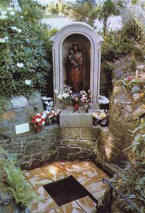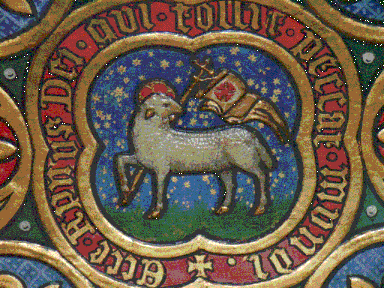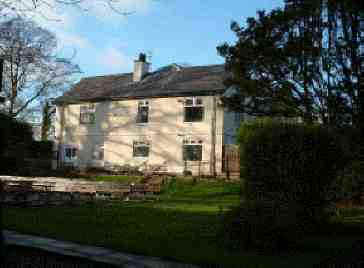LADYEWELL
 The Reformation in England brought the Protestant
Church into being but, sadly, not without some persecution of Catholics who
still clung to their faith. The county of Lancashire, still one of the most
Catholic in the land, suffered a great deal. Catholics were persecuted, fined
for recusancy (refusal to worship in the Anglican church), and lost their lands.
It was particularly dangerous to say the Mass and many priests lost their lives
when they were discovered. In these perilous times, the elements of the Mass and
artifacts that were central to
the Catholic faith were protected and hidden away.
Many shrines were destroyed particularly when they had connections with an abbey
whose wealth Henry VIII had designs upon. However, some survived and remained a
place of pilgrimage for the faithful and one such is on our doorstep in
Fernyhalgh, the Holy Well dedicated to the Virgin Mary - Ladyewell.
The Reformation in England brought the Protestant
Church into being but, sadly, not without some persecution of Catholics who
still clung to their faith. The county of Lancashire, still one of the most
Catholic in the land, suffered a great deal. Catholics were persecuted, fined
for recusancy (refusal to worship in the Anglican church), and lost their lands.
It was particularly dangerous to say the Mass and many priests lost their lives
when they were discovered. In these perilous times, the elements of the Mass and
artifacts that were central to
the Catholic faith were protected and hidden away.
Many shrines were destroyed particularly when they had connections with an abbey
whose wealth Henry VIII had designs upon. However, some survived and remained a
place of pilgrimage for the faithful and one such is on our doorstep in
Fernyhalgh, the Holy Well dedicated to the Virgin Mary - Ladyewell.
The story of the shrine is a romantic one and
begins in Ireland in the county of Fermanagh. Fergus Maguire, son of a
chieftain, is crossing the Irish Sea in an horrendous storm homeward bound after
a trading mission. Believing that shipwreck and death are imminent, he prays to
God imploring his help and promising that he will perform some pious act if he
and his crew are saved. His prayer is answered and the stricken galley finds
landfall in a sheltered estuary near Liverpool. Fergus and his crew fall asleep
completely exhausted. In his sleep, Fergus hears a voice which tells him to
"go to Fernyhalgh and there where thou shall find a crab tree having
coreless fruit, hanging over a shrine, build me a chapel". The next day
Fergus began his long quest to find the shrine. Not surprisingly, no-one in
Liverpool had ever heard of Fernyhalgh and it was a long and lonely road he
travelled and many times he almost lost heart. On a day in November he was
lodged at a house in Priest Town. The lady of the house was rebuking her maid
servant for her late return. The maid replied that it was the dun cow that was
at fault because she had strayed much further than usual and had eventually been
found at Fernyhalgh. The maid had a gnarled branch which she used to drive the
cow and from it hung a few crab apples which, when Fergus cut open, turned out
to be coreless as in the dream. The next day the maid took him to a remote spot
where there was a well in a hollow. He discovered a large stone that had the
shape of a mother and child chiselled on it leading him to believe that the
Virgin Mary had been honoured here before. Here he built his chapel honouring
his promise. It is not easy to ascertain the date of the first chapel but in
1348-49 there was certainly an oratory at Fernyhalgh. The year 1471 was the date
quoted when Fergus was caught in the storm. Possibly the original shrine had
been abandoned. The story of the well and Fergus comes from the pen of the
Reverend Christopher Tuttell who served as the priest at Fernyhalgh from 1699 to
1727 and he relates the events as he knew them up to his time as priest there.
In 1547, under the rule of the Protestant king Edward VI, the chapel was
destroyed and its contents confiscated. Despite this, Catholics continued to
worship at the well on Sundays and Holy Days. Towards the end of the reign of
Charles I, a second chapel was built in honour of Our Lady of Fernyhalgh beside
the Holy Well and it prospered and was a centre of worship until the time of
George I when once again Catholics were persecuted.
 Father Tuttell saw the chapel plundered and on
occasions, he had to hide from soldiers and eventually had to flee the district.
Happily, it was not the end and he returned to his ministry at Fernyhalgh and
ended his days in 1727 to be succeeded by his old friend Edward Melling.
Father Tuttell saw the chapel plundered and on
occasions, he had to hide from soldiers and eventually had to flee the district.
Happily, it was not the end and he returned to his ministry at Fernyhalgh and
ended his days in 1727 to be succeeded by his old friend Edward Melling.
Although, the chapel had suffered looting etc.,
it had managed to survive until the time of the 1745 Jacobite Rebellion when
angry Protestants burned it to the ground. The priest of the time rebuilt it and
it served the community for the next few decades when it became too small to
cope with the now increased congregation. The resident priest was then Anthony
Lund and it was under his ministry that a new church was built some ten minutes
walk from the well.
This was built to look like a residence from the
outside which was a common practice in times of unpopularity with the
authorities. Some Catholic churches were built to look like barns. This church
is the present St Maryís and it was formally opened in 1794, thirty five years
before the passing of the Catholic Emancipation Act.
With the opening of the new church, the last
chapel was closed. The old house which Father Lund had known became somewhat
decayed. In 1842 it was restored and became an academy for young ladies before
in 1850 becoming the convent of the Sisters of the Holy Child Jesus. In 1821 an
ancient stone cross still stood beside the Well and another, incised with the
initials J.N.R.J. stood in the orchard. Twenty years later the crab tree had
been felled and the cross by the well removed. However, as often with the shrine
here, by 1850 the Well had been restored.
Amazingly, the original bell said to have been
purchased by Fergus and removed in 1547, found its way home to Fernyhalgh. In
1996 a nun in Toulouse wrote to Ladyewell to say that a bell inscribed with the
word Maguire had been discovered in the attic. In the 1600ís the Maguire
family had fled to France from Ireland to avoid persecution and had lived in a
Mercantile House in Toulouse. The bell was returned to Ladyewell and along with
other items of interest such as the Burgess Altar (which has its own story) is a
prominent feature.
We now live in enlightened and tolerant times at
peace with our Catholic neighbours.
It is a tribute to countless ordinary Catholics who kept their faith alive
during years of persecution that the Shrine of Our Lady at Ladyewell has
survived and is an important place of pilgrimage today. It is a beautiful place
and, apart from the roar of the motorway, a place of peace and tranquility. You
can drink from the well, pray beside the Shrine to Our Lady, walk in the garden
dedicated to Padre Pio and visit Ladyewell House or just simply sit and
experience Ladyewell. I visited it for the first time only last month and along
with the crypt at Lastingham and the Chalice garden at Glastonbury, found it to
be a very spiritual place. If you havenít been, please go there and see for
yourself.
Barbara Hothersall
Directions to Ladyewell
- Leave the M6 at J32 / M55 at Broughton
- At the roundabout take the 1st exit onto
Garstang Road (A6) signposted Preston
- Turn immediately left on to Eastway (B6241)
signposted Ribbleton (B6242) and Longridge (B6243). Also signposted
Ladyewell.
- At the roundabout take the 3rd exit
signposted Ladyewell on Eastway (B6241)
- After 0.15 miles at the roundabout take the
first exit signposted Ladyewell on to DíUrton Lane
- Travel for 0.73 miles (crossing the M6) and
turn right into Fernyhalgh Lane signposted Ladyewell
- You will pass the Nursery School and St.
Maryís on your left.
- Ladyewell House is approximately 0.25 miles
along the lane, right at the ĎTí junction.
See also www.ladyewell.co.uk/
 The Reformation in England brought the Protestant
Church into being but, sadly, not without some persecution of Catholics who
still clung to their faith. The county of Lancashire, still one of the most
Catholic in the land, suffered a great deal. Catholics were persecuted, fined
for recusancy (refusal to worship in the Anglican church), and lost their lands.
It was particularly dangerous to say the Mass and many priests lost their lives
when they were discovered. In these perilous times, the elements of the Mass and
artifacts that were central to
the Catholic faith were protected and hidden away.
Many shrines were destroyed particularly when they had connections with an abbey
whose wealth Henry VIII had designs upon. However, some survived and remained a
place of pilgrimage for the faithful and one such is on our doorstep in
Fernyhalgh, the Holy Well dedicated to the Virgin Mary - Ladyewell.
The Reformation in England brought the Protestant
Church into being but, sadly, not without some persecution of Catholics who
still clung to their faith. The county of Lancashire, still one of the most
Catholic in the land, suffered a great deal. Catholics were persecuted, fined
for recusancy (refusal to worship in the Anglican church), and lost their lands.
It was particularly dangerous to say the Mass and many priests lost their lives
when they were discovered. In these perilous times, the elements of the Mass and
artifacts that were central to
the Catholic faith were protected and hidden away.
Many shrines were destroyed particularly when they had connections with an abbey
whose wealth Henry VIII had designs upon. However, some survived and remained a
place of pilgrimage for the faithful and one such is on our doorstep in
Fernyhalgh, the Holy Well dedicated to the Virgin Mary - Ladyewell. Father Tuttell saw the chapel plundered and on
occasions, he had to hide from soldiers and eventually had to flee the district.
Happily, it was not the end and he returned to his ministry at Fernyhalgh and
ended his days in 1727 to be succeeded by his old friend Edward Melling.
Father Tuttell saw the chapel plundered and on
occasions, he had to hide from soldiers and eventually had to flee the district.
Happily, it was not the end and he returned to his ministry at Fernyhalgh and
ended his days in 1727 to be succeeded by his old friend Edward Melling.